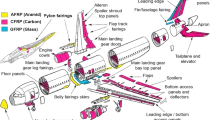Abstract
The purpose of this study was to anchor basalt-reinforced polymers in an aluminum grip using dry friction. Dry friction clamping is considered the optimal solution for post-mounting of load-bearing terminations on composite structures. A new test method is presented for characterizing the frictional load transfer behavior of the grip. To carry out the study, a custom-built test rig was used to examine the relation between pullout force and clamping force. The anchoring method was found to be successful. The paper presents details on the custom-built test rig, along with the use of digital image correlation for displacement monitoring. Pullout results and validation tests are presented. In the discussion, the results and the importance of the grips surface finish with regard to pullout force are discussed. The discussion was backed by investigations on wear patterns using SEM.
















Similar content being viewed by others
References
Schmidt, J.W., Bennitz, A., Täljsten, B., Goltermann, P., Pedersen, H.: Mechanical anchorage of FRP tendons—a literature review. Constr. Build. Mater. 32, 110–121 (2012)
Nordin, H.: Strengthening structures with externally prestressed tendons, literature review. Technical Report 2005: 06, Lulea University of Technology (6.3. 3 Grout-Potted Anchorages, 37–38) (2005)
Mitchell, R.: High-strength end fittings for FRP rod and rope. J. Eng. Mech. Div. 100, 687–706 (1974)
Rostasy, F.S., Kepp, B.: Verhalten dynamisch beanspruchter GFK-Spannglieder: Abschlussbericht zum Forschungsvorhaben; Untersuchung im Auftr. der DFG (Az.: Ro 288/18-1). Institut für Baustoffe, Massivbau und Brandschutz (1986)
Rostásy, F.: Draft guidelines for the acceptance testing of FRP posttensioning tendons. J. Compos. Constr. 2, 2–6 (1998)
Rostasy, F.S.: New approach in the already published recommendations for anchorage assembly. In: Proceedings of 9th Congress of Federation Internationale de La Precontrainte pp. 95–98 (1982)
Taha, M.: New concrete anchors for carbon fiber-reinforced polymer post-tensioning tendons—part 1: state-of-the-art review/design. ACI Struct. J. 100, 86–95 (2003)
Taha, M.: New concrete anchors for carbon fiber-reinforced polymer post-tensioning tendons—part 2: development/experimental investigation. ACI Struct. J. 100, 96–104 (2003)
Burgoyne, C.: Structural use of parafil ropes. Constr. Build. Mater. 1, 3–13 (1987)
Sayed-Ahmed, E.: A new steel anchorage system for post-tensioning applications using carbon fibre reinforced plastic tendons. Can. J. Civ. Eng. 25, 113–127 (1998)
Al-Mayah, A., Soudki, K., Plumtree, A.: Effect of sleeve material on interfacial contact behavior of CFRP-metal couples. J. Mater. Civ. Eng. 18, 825–830 (2006)
Al-Mayah, A., Soudki, K.A., Plumtree, A.: Experimental and analytical investigation of a stainless steel anchorage for CFRP prestressing tendons. PCI J. 46, 88–100 (2001)
Al-Mayah, A., Soudki, K., Plumtree, A.: Effect of rod profile and strength on the contact behavior of CFRP-metal couples. Compos. Struct. 82, 19–27 (2008)
Portnov, G.G., Kulakov, V.L., Arnautov, A.K.: A refined stress–strain analysis in the load transfer zone of flat specimens of high-strength unidirectional composites in uniaxial tension 2. Finite-element parametric analysis. Mech. Compos. Mater. 43, 29–40 (2007)
Schön, J.: Coefficient of friction for aluminum in contact with a carbon fiber epoxy composite. Tribol. Int. 37, 395–404 (2004)
Schön, J.: Coefficient of friction of composite delamination surfaces. Wear 237, 77–89 (2000)
ISO: ISO 4287: Geometriske produktspecifikationer (GPS). Overfladebeskaffenhed. Profilmetode. Termer, definitioner og overfladebeskaffenhedsparametre (1998)
Bowers, R.: Coefficient of friction of high polymers as a function of pressure. J. Appl. Phys. 42, 4961 (1971)
Ben-David, O., Fineberg, J.: Static friction coefficient is not a material constant. Phys. Rev. Lett. 106, 1–4 (2011)
Al-Mayah, A.: Effect of sandblasting on interfacial contact behavior of carbon-fiber-reinforced polymer-metal couples. J. Compos. Constr. 9, 289–295 (2005)
Acknowledgments
The financial support of the Danish Agency for Science, Technology and Innovation, Grant Number 0604-00909, is gratefully acknowledged.
Author information
Authors and Affiliations
Corresponding author
Rights and permissions
About this article
Cite this article
Costache, A., Glejbøl, K., Sivebæk, I.M. et al. Friction Joint Between Basalt-Reinforced Composite and Aluminum. Tribol Lett 59, 30 (2015). https://doi.org/10.1007/s11249-015-0556-8
Received:
Accepted:
Published:
DOI: https://doi.org/10.1007/s11249-015-0556-8




